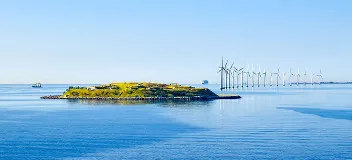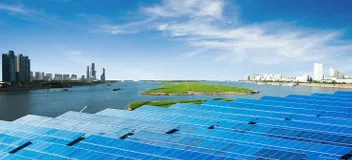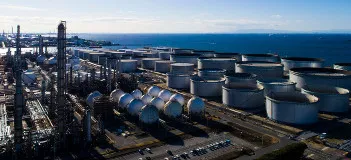DNV held the Singapore Energy Transition Conference on 23 March to launch our South East Asia findings for our Energy Transition Outlook report. Joined by ten speakers across the industry, participants explored how Singapore and the broader South East Asian region is well positioned to help accelerate the energy transition.
The energy transition is shifting national agendas and is cutting across all industries and markets. As a global hub for innovation, Singapore has built a vibrant ecosystem to advance today’s efforts on energy and climate change. With South East Asia’s energy demand forecasted to grow by 50% by 2050, alternative energy sources need to be explored quickly to move on the decarbonization pathway.
The key messages from the sessions included:
Transforming our energy systems
First, the energy transition will bring large changes to South East Asia’s energy system in the next thirty years. Fossil fuels will continue to play a dominant role in the region’s energy supply, which will see gas continue to increase. Solar PV and wind will both record strong growth as a result of the massive rise in end user electrification and the electrification of vehicles and industry. Renewables development will also expand offshore.
Building momentum
Second, Singapore’s energy journey highlights how governments can play a key role in accelerating the energy transition towards more sustainable energy sources while maintaining energy security and affordability. The Singapore energy strategy rests on four pillars which are comprised of:
- Natural gas – While natural gas will remain as Singapore’s dominant fuel, the government is helping power generation companies improve the efficiency of their power plants.
- Solar energy – The Singapore government is ramping up solar energy production in the country by setting ambitious solar targets of 1.5 GWp by 2025, 2 gigawatt-peak (GWp) by 2030 and an energy storage target of 200 MW beyond 2025.
- Regional power grids – Singapore is exploring ways to tap on regional power grids to access cost-competitive renewable energy produced in other markets.
- Emerging low-carbon alternatives – Singapore is also looking into emerging low-carbon solutions through public-private partnerships that have the potential to help reduce Singapore's carbon footprint. These technologies include carbon capture, utilization and storage (CCUS) technologies and hydrogen.
Considering the urgency of climate change, market forces alone will not always be sufficient to provide the pace needed in the transition. It is key that governments in the region invest in new technologies focusing on the further expansion of renewables, power grid expansion, decarbonization of existing assets and the integration of these systems to enable a cleaner and more sustainable transition.
Shifting mindsets
Third, on the role of the private sector, companies are increasingly taking an active stand in limiting their carbon emissions and are taking steps to decarbonize their supply chain. Companies have become more engaged and have been making an effort to better understand their carbon footprint.
However, a stronger response to the threats of climate change is required as the time window for action is very tight. The world needs to keep reducing its energy consumption by 8% every year if climate change is to be tackled.
In terms of power generation, solar, wind and energy storage systems should be scaled up while the consumption of fuels which have a very high carbon footprint such as coal should be scaled down.
Investments for grid upgrades are required in order to integrate and balance these energy systems in the overall energy mix.
But this technological shift must be accompanied by a cultural change. Company-wide mindset changes will be needed so that the staff gain a shared understanding of clean technologies and decarbonization and the benefits they provide. In addition, an upgrade of skill sets and the re-training of staff will also be required. Engineers will need to learn new tools to help them decarbonize their processes and systems.
With the current geopolitical power shift, South East Asia is poised to play a larger role in the global supply chain. By taking on this more prominent role, the sustainability standards by which South East Asian companies are measured against are raised. This forces them to improve their sustainability processes and align their practices with best in class global standards. Similarly, governments and regulators have announced plans committing to Net Zero goals. These frameworks include an industrial component which will mandate companies to conform to stricter emissions targets.
Enabling the energy transition with science and technology
Fourth, we need to embrace new technologies to advance the low-carbon transition.
Technology has been a major enabler and accelerator that has shaped the decarbonization agenda. A number of companies have been looking at technologies that are at the forefront of the energy transition. Developments in floating offshore wind, new PV panel technologies (lightweight PV, organic PV, bifacial cells), green and novel shipping technologies, and game changing CCUS and hydrogen technologies will transform our energy future. Hydrogen applications for decarbonization, e-mobility, fossil fuel replacement look particularly promising.
There is no silver bullet that can single-handedly solve the energy dilemma. The heightened demand for electrification will require a combination of solar, wind, hydro and gas power generation in the next decades.
A number of breakthrough technology work is also taking place in Singapore. DNV is proudly and closely involved in both the Centre of Excellence in Additive Manufacturing and the Centre of Excellence in Maritime Decarbonization and Autonomy. In both cases, DNV aims to combine Singapore-based competence with its business objective to help customers and society at large tackle major transformations.
In the maritime space, Singapore is an excellent hub for the design, innovation and certification of vessels. With the transition to decarbonization, Singapore can play a key role as a major world marine and offshore marine decarbonization centre.
While LNG will remain important as a transition fuel, ammonia, bioethanol and hydrogen as a building block for carbon-neutral fuels offer bright prospects for the future. Many hydrogen and ammonia developments are being pursued today but before these technologies can be made commercially viable, safety considerations will have to be addressed.
All these emerging technologies will advance the carbon neutrality of fuel sources which will also make available sustainable and affordable energy solutions.
Pushing ahead towards a sustainable future
Fifth, cross-sector collaboration and partnerships across the value chain are important enablers to accelerate the energy transition. By working together, the industry’s best ideas can come together. Partnering with like-minded companies can boost collaboration and will yield better outcomes than by working in isolation.
As decarbonization has become a shared imperative across industry players, partners can cooperate on R&D, the reduction of the levelized cost of electricity (LCOE) and the development and commercialization of new technologies.
To conclude, technology is facilitating the advancement of decarbonization practices. Harnessing these technologies through global cooperation, government policy innovations and a mindset change look set to change the energy landscape. But only with a coordinated response can industry take more meaningful action to reduce its carbon footprint and accelerate the energy transition.
Please click the corresponding links to access the on-demand recording and/or the event highlights.








